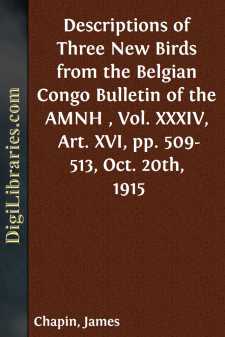Categories
- Antiques & Collectibles 13
- Architecture 36
- Art 48
- Bibles 22
- Biography & Autobiography 813
- Body, Mind & Spirit 142
- Business & Economics 28
- Children's Books 15
- Children's Fiction 12
- Computers 4
- Cooking 94
- Crafts & Hobbies 4
- Drama 346
- Education 46
- Family & Relationships 57
- Fiction 11829
- Games 19
- Gardening 17
- Health & Fitness 34
- History 1377
- House & Home 1
- Humor 147
- Juvenile Fiction 1873
- Juvenile Nonfiction 202
- Language Arts & Disciplines 88
- Law 16
- Literary Collections 686
- Literary Criticism 179
- Mathematics 13
- Medical 41
- Music 40
- Nature 179
- Non-Classifiable 1768
- Performing Arts 7
- Periodicals 1453
- Philosophy 64
- Photography 2
- Poetry 896
- Political Science 203
- Psychology 42
- Reference 154
- Religion 513
- Science 126
- Self-Help 84
- Social Science 81
- Sports & Recreation 34
- Study Aids 3
- Technology & Engineering 59
- Transportation 23
- Travel 463
- True Crime 29
Descriptions of Three New Birds from the Belgian Congo Bulletin of the AMNH , Vol. XXXIV, Art. XVI, pp. 509-513, Oct. 20th, 1915
by: James Chapin
Description:
Excerpt
The whole of the large collection of birds secured by the Congo Expedition of the American Museum of Natural History during the years 1909 to 1915, under the leadership of Mr. Herbert Lang, has now arrived safely at the Museum. It is composed of material gathered all across the Belgian Congo, from Boma on the west to Aba in the northeastern corner, but the greater part from the more remote territory between Stanley Falls and the Enclave of Lado, including the dense equatorial forests of the Ituri, Nepoko, and Bomokandi, and the high-grass and bush country of the Uele District to the north and northeast.
Of the relatively small number of zoölogical expeditions that have passed through and collected in these regions, none has ever before been able to make such a prolonged stay, and the varied zoölogical results of this Expedition are surely of the highest scientific interest. The ornithological collection contains in the neighborhood of six thousand skins, and represents some 600 different species, a number of them of course new to science. These it is our purpose to describe as promptly as possible in this Bulletin, before taking up the greater work of a general report on all the forms collected, with more extended notes on their distribution, habits, food, and nests.
Descriptions of the first three new forms follow:
Chætura melanopygia sp. nov.
Related to C. stictilæma, but much larger, with feathers of upper breast more heavily margined with blackish, and without any trace of a light rump-band.
Description of type, collector's No. 4986 Congo Exp. A. M. N. H., ââ¢â ad. Avakubi, Ituri District, Belgian Congo, Aug. 15, 1913.
Upper parts brownish-black (chætura-black, Ridgw.) becoming black on wings and tail, with faint violet and green reflections (green on freshly molted feathers). Ear coverts drab, bordered with fuscous-black; feathers of throat pale smoke-gray, margined with fuscous, those of upper breast similar, but heavily bordered with fuscous-black, consequently with a very pronounced "scaly" appearance; lower breast growing darker, so that the dark borders are less conspicuous, and the feathering of the belly completely fuscous-black with slight oily gloss. Under wing coverts mouse-gray with darker edges, flanks and under tail-coverts black with slight greenish gloss. Tail slightly rounded.
Iris dark brown, bill black, feet bluish, shading to dusky brown on tips of toes and claws. Sexual organs enlarged.
Length (skin) 145 mm.; wing 164; tail 49.5; bill (exposed culmen), 7.5; metatarsus 13.
Only one specimen secured, out of two or three of these swifts that were flying about over the Ituri River, in company with several examples of Chætura cassini. In spite of our long stay in this region, the species was not again positively recognized; but Chætura cassini, C. stictilæma and C. sabinei were all of common occurrence there.
Resembling Apaloderma narina, but decidedly smaller, of different coloration, and with bill less swollen. The serration of the maxilla is less pronounced.
The adult male of A. minus is distinguished by the bluer hue of the forehead, throat, and upper breast, which show in certain lights deep violet reflections, and by the more scarlet, less crimson color of the remaining underparts. In life the naked areas on the cheeks are bright yellow, whereas in A. narina they are light green.
The adult female differs in the more tawny or ochraceous coloration of the breast, which is grayish in this sex of A. narina, although sometimes washed with light brown on the upper breast. A greenish gloss on the upper breast is more common in females of A....


